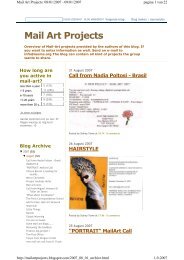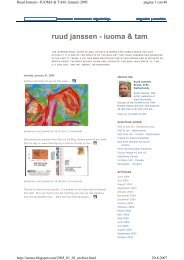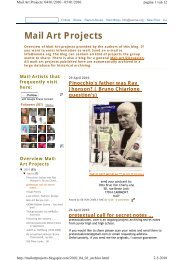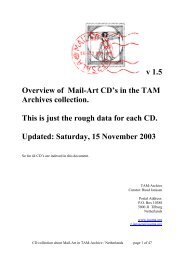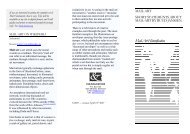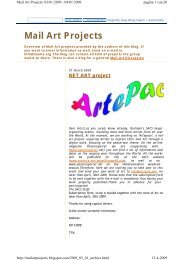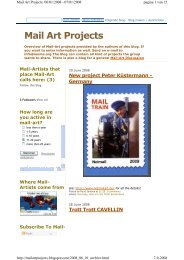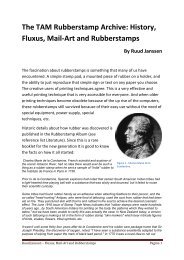- Page 1 and 2:
Géza PerneczkyNETWORK ATLASWorks a
- Page 3 and 4:
317Oberholzer, Christoph Turbinenha
- Page 5 and 6:
31968 p., Exh.: Gesamthochschule, M
- Page 7 and 8:
321(5x) in plastic box {999}. Tiege
- Page 9 and 10:
323Über das Dichtertum für J. O.
- Page 11 and 12:
325drawings, 32 p.Pat → Fish: Nin
- Page 13 and 14:
327front of each copy, so each rece
- Page 15 and 16:
329^Tema y variaciones. (Colletive
- Page 17 and 18:
331denouncing the suppression of hu
- Page 19 and 20:
333!Panpost! → Bloch, Mark S.Pap,
- Page 21 and 22:
335Literature:«Coop mail art proje
- Page 23 and 24:
337(France), Klaus Groh (Germany),
- Page 25 and 26:
339^Forty Six. Instruments of Desir
- Page 27 and 28:
341formed as postcards or «letters
- Page 29 and 30:
343^# N°5-6 (1978), N°7 (1978), N
- Page 31 and 32:
345(John Held Jr.: Assembling Perio
- Page 33 and 34:
347^ME (Edited by !Pittore Euforico
- Page 35 and 36:
349«...I began my Network mail art
- Page 37 and 38:
351~Source:Literature:print on whit
- Page 39 and 40:
353with an interest for the undergr
- Page 41 and 42:
355our five senses. Along with tast
- Page 43 and 44:
357Muzeum Sztuki Aktualnej, Kraków
- Page 45 and 46:
359Pütz, Claudia PIPS, Dada-Corpor
- Page 47 and 48:
361page with green paper. Additiona
- Page 49 and 50:
363GDR with essays, catalogues and
- Page 51 and 52:
3658 Portraits - suicide graphique
- Page 53 and 54:
367Robakowski, Joseph Ul. Mickiewic
- Page 55 and 56:
369& concept art, also assembling i
- Page 57 and 58:
371^# 1/1, 2; 2/1, 2, 3; 3/1; 4/II.
- Page 59 and 60:
373^The Risk. Cutted Fragments of N
- Page 61 and 62:
375centralized mail art congress as
- Page 63 and 64:
377was the concept of this magazine
- Page 65 and 66:
379Rutkovsky, Paul / Cutrell, Fran.
- Page 67 and 68:
381S:t Petri, Galerie→ Sellem, Je
- Page 69 and 70:
383Sarenco, Amodulo Calaone Baone (
- Page 71 and 72:
385/ Russian. Ed. Gertraud Scholz,
- Page 73 and 74:
387(About Smirk /Smile #4): «...Th
- Page 75 and 76:
389The Bremen-Kassel Connection (A
- Page 77 and 78:
391Roy Adzak: Screws (Object book,
- Page 79 and 80:
393NEUES MUSEUM WESERBURG BREMEN.(T
- Page 81 and 82:
395Schwerin: Staatliches Museum^Mai
- Page 83 and 84:
397^Mail Art Puzzle Project. ongio
- Page 85 and 86:
399«Seul, Kwan Hoon Museum», Seul
- Page 87:
401^Gorbachev / Gorbi, Mail Art Pro
- Page 90 and 91:
404^happening & fluxus (Edited by H
- Page 92 and 93:
406*R. Thomas, W. Ting, **B. Watts,
- Page 94 and 95:
408haeadquartier's lobby during Feb
- Page 96 and 97:
410Art competitions, music. Stateme
- Page 98 and 99:
412Géza Perneczky: The Magazine Ne
- Page 100 and 101:
414Stempelplaats Editions:→ Banan
- Page 102 and 103:
416(Fashion, #1): «... features wo
- Page 104 and 105:
418^Il Granaio / Pittura - Mostra a
- Page 106 and 107:
420^Soviet & Eastern European Mail
- Page 108 and 109:
422Magazines. International Network
- Page 110 and 111:
424Szczelkun, Stefan 85 St. Agnes P
- Page 112 and 113:
426(WOW and other publications from
- Page 114 and 115:
428[→ Hoffberg], Vol. 3, #1, 17 p
- Page 116 and 117:
430Thurner, Hans→ Lechner, UteTif
- Page 118 and 119:
432of potentially interested paprti
- Page 120 and 121:
434(...)As you might know the inter
- Page 122 and 123:
436this new series has been numbere
- Page 124 and 125:
438points to the signalism sources
- Page 126 and 127:
440voor mij onmiddelijk een van de
- Page 128 and 129:
442190182 (untitled). The fanzine
- Page 130 and 131:
444{100}.140686 COPYING TOYS. Actio
- Page 132 and 133:
446Tron, Otto ? River Fall, WI USA
- Page 134 and 135:
448^#1-17Luther → Blissett & Stew
- Page 136 and 137:
4501973. 1 p.)Géza Perneczky: The
- Page 138 and 139:
452Vancouver East Culture Centre, O
- Page 140 and 141:
454~Source:~Literature:audio & visu
- Page 142 and 143:
456as a nostalgic joint. (...)With
- Page 144 and 145:
458Vitale, Angelo Via Settembrini 2
- Page 146 and 147:
460perimental literature [also some
- Page 148 and 149:
462^Every Woman is a Gentleman. Doc
- Page 150 and 151:
464already transforming as the ethe
- Page 152 and 153:
466Wien, A-1080), 1989^Mail Art Por
- Page 154 and 155:
468Klaus Werner (1978): Künstlelrp
- Page 156 and 157:
470Wozniak, Ryszard Ul. Spolska 5.
- Page 158 and 159:
472Strategic for Wracking Hylic. (1
- Page 160 and 161:
474amson...»(Lightworks [→Burch]
- Page 162 and 163:
476Univer sity of Chicago and read
- Page 164 and 165:
478Zerpa, Carlos Urb. Los Sauces, C
- Page 166 and 167:
482A P P E N D I X(General bibliogr
- Page 168 and 169:
484°Rutkovsky, Paul: Visual Satire
- Page 170 and 171: 486→ Perneczky, G.: The Story of
- Page 172 and 173: 488Periodics by Original Graphics b
- Page 174 and 175: 490Radlov, Sergej: Kurze Einführun
- Page 176 and 177: 492Model Peltex. 3 rue des Couples.
- Page 178 and 179: 494United States of Mind = Anna Ban
- Page 180 and 181: 496Art. Contemporary Art Press (→
- Page 182 and 183: 498→ Guy Bleus: Philately: Mail A
- Page 184 and 185: 500I Cardona, Carolee Schneemann, A
- Page 186 and 187: 502→ MacLeod, Scott: Art Strike.
- Page 188 and 189: 504→ Dunn, Lloyd: Editorial. (For
- Page 190 and 191: 506Objeto Biografico. 21x31 cm., xe
- Page 192 and 193: 508^Copy Art. Trocken schreiben - i
- Page 194 and 195: 510Les lignes brisées.Le panier de
- Page 196 and 197: 512→^Banana, Anna: About VILE (Le
- Page 198 and 199: 514→^Ruch, Günther: Mail Art Con
- Page 200 and 201: 516Karol Sauerland: On the Latitude
- Page 202 and 203: 518Press, London, 1988. Tetxts by K
- Page 204 and 205: 520The Curch of the SubGenius, Dall
- Page 206 and 207: 522LOUISE LITSZActor and singer, me
- Page 208 and 209: 524Mail Art) In: The Magazine Netwo
- Page 210 and 211: 526→ Kocman, J. H.: Stamp Activit
- Page 212 and 213: 528→ Vigo, E. A.: Small Creative
- Page 214 and 215: 530offset, 16 p. {500} In: Ed. «co
- Page 216 and 217: 532*Abracadada - Box 210367. San Fr
- Page 218 and 219: 534AustraliaSMIRK #1 by «Sam Monk
- Page 222 and 223: 538«Suicide» as a Network Idea→
- Page 224 and 225: 540konkrete poëzie? / concrete poe
- Page 226 and 227: 542offset / colour, 144 p. Galerie
- Page 228 and 229: 544Tischkov) In: ersichtlichkeiten,
- Page 230 and 231: Acuse de recibo (Mail Art project w
- Page 232 and 233: 548And / „&“ (Mail Art project,
- Page 234 and 235: 550Art is Books (exh. at the Centr.
- Page 236 and 237: 552Artists' Books, Permanent Collec
- Page 238 and 239: 554Audio Mail Art: Introvision (inf
- Page 240 and 241: Big Art (1 km², concpetual publ. o
- Page 242 and 243: 558Bric a Brac (Mail Art zine, anno
- Page 244 and 245: Cella n. 27851, (Mail Art exh., 198
- Page 246 and 247: 562Commodity Character (Photoreport
- Page 248 and 249: 564„Cosey Fanni Tutti“ (artist
- Page 250 and 251: „Dazar“ / „Omahaha“ / „Po
- Page 252 and 253: 568Drucksache (Mag. with poetry, gr
- Page 254 and 255: Envelope and its Contents (Mail Art
- Page 256 and 257: 572Fast-Lift Mail Art Project (1994
- Page 258 and 259: 574Fluxu Action #1 - incongruous me
- Page 260 and 261: 576General Idea (eds.): FILE magazi
- Page 262 and 263: „Harlekin Art“ (post-Fluxus, Ma
- Page 264 and 265: 580I Support the Postal Workers (Co
- Page 266 and 267: 582Int. Mail Art Exh. (at the Postk
- Page 268 and 269: Kepler (Mail Art prj., Wendelinskap
- Page 270 and 271:
Laughing Bear - Newsletter (Magazin
- Page 272 and 273:
588Luna Bisonte Prods. / Lost and F
- Page 274 and 275:
Mail etc. Art (exh. at the Universi
- Page 276 and 277:
mEINBLICK (Mail Art at the Gal. im
- Page 278 and 279:
594(Moon Faces:) The Springfullmoon
- Page 280 and 281:
596Neoist Para-Festival - APT '80 (
- Page 282 and 283:
Obscurities - Mail Art / Missing Do
- Page 284 and 285:
P. S. (Tabloid for the int. perform
- Page 286 and 287:
602Photography thematical postcards
- Page 288 and 289:
Positiv-Negativ (Commonpress #8, 19
- Page 290 and 291:
606Prison, Today Art is a... (Mail
- Page 292 and 293:
Recycling Mail (assembled matterial
- Page 294 and 295:
610Newspaper: The Stampa / (Inv. to
- Page 296 and 297:
612Season's Greetings (Mail Art prj
- Page 298 and 299:
Sky Views Magazine (new and alterna
- Page 300 and 301:
616Stamp Art (offset cat. for the c
- Page 302 and 303:
618Synapse, Visual Art Press for Ar
- Page 304 and 305:
Timbro d'Artista (Mail Art project
- Page 306 and 307:
622Un Regard Moderne (tabloid size
- Page 308 and 309:
624Visual Poetry 1985-1995 (exh. at
- Page 310 and 311:
626WO. Visuella Poesie in Berlin (l
- Page 312 and 313:
628Zeitschrift für alles - Review
- Page 314 and 315:
ABBREVIATIONSMagazines: m. = monthl



